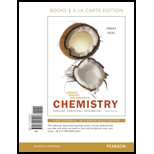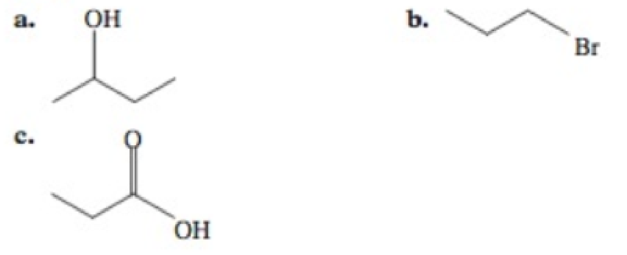
GENERAL ORGANIC+BIO...(LL)-W/MOD.ACCESS
3rd Edition
ISBN: 9780134466699
Author: FROST
Publisher: PEARSON
expand_more
expand_more
format_list_bulleted
Concept explainers
Textbook Question
Chapter 4, Problem 4.41AP
Convert the skeletal structures shown to condensed structures.

Expert Solution & Answer
Trending nowThis is a popular solution!

Students have asked these similar questions
When talking about the acidity of carboxylic acids, is it the same thing to say higher or stronger acidity?
Using the following two half-reactions, determine the pH range in which $NO_2^-\ (aq)$ cannot be found as the predominant chemical species in water.* $NO_3^-(aq)+10H^+(aq)+8e^-\rightarrow NH_4^+(aq)+3H_2O(l),\ pE^{\circ}=14.88$* $NO_2^-(aq)+8H^+(aq)+6e^-\rightarrow NH_4^+(aq)+2H_2O(l),\ pE^{\circ}=15.08$
Indicate characteristics of oxodec acid.
Chapter 4 Solutions
GENERAL ORGANIC+BIO...(LL)-W/MOD.ACCESS
Ch. 4 - Prob. 4.1PPCh. 4 - Prob. 4.2PPCh. 4 - Prob. 4.3PPCh. 4 - Draw a skeletal structure for ethane, C2H6. Do you...Ch. 4 - Prob. 4.5PPCh. 4 - Prob. 4.6PPCh. 4 - Draw a Lewis structure for each of the following...Ch. 4 - Draw a Lewis structure for each of the following...Ch. 4 - Prob. 4.9PPCh. 4 - Prob. 4.10PP
Ch. 4 - Prob. 4.11PPCh. 4 - Prob. 4.12PPCh. 4 - Write the condensed structure for the...Ch. 4 - Write the condensed structure for the...Ch. 4 - Write the skeletal structure for the alkane shown:...Ch. 4 - Write the skeletal structure for the alkane shown:...Ch. 4 - Identify the family of hydrocarbon present in the...Ch. 4 - Identify the family of hydrocarbon present in the...Ch. 4 - Identify all the functional groups present in the...Ch. 4 - Prob. 4.20PPCh. 4 - The most prevalent fatty acid in coconut oil is...Ch. 4 - The most common fatty acid found in animals is...Ch. 4 - Draw the condensed structural formula for each of...Ch. 4 - Give the correct name for each of the following...Ch. 4 - Draw the skeletal structure for each of the...Ch. 4 - Prob. 4.26PPCh. 4 - Prob. 4.27PPCh. 4 - Prob. 4.28PPCh. 4 - Prob. 4.29PPCh. 4 - Prob. 4.30PPCh. 4 - Determine the relationship between each of the...Ch. 4 - Determine the relationship between each of the...Ch. 4 - Determine if each of the following cycloalkanes or...Ch. 4 - Determine it each of the following cycloalkanes or...Ch. 4 - Mark the chiral centers in the following...Ch. 4 - Mark the chiral centers in the following...Ch. 4 - Convert each of the Lewis structures shown into a...Ch. 4 - Convert each of the Lewis structures in Problem...Ch. 4 - Prob. 4.39APCh. 4 - Prob. 4.40APCh. 4 - Convert the skeletal structures shown to condensed...Ch. 4 - Convert the skeletal structures shown to condensed...Ch. 4 - Prob. 4.43APCh. 4 - Prob. 4.44APCh. 4 - Alkanes are also referred to as saturated...Ch. 4 - Are alkanes considered polar or nonpolar...Ch. 4 - Give the skeletal structure and name of the...Ch. 4 - Give the skeletal structure and name of the...Ch. 4 - Name the following straight-chain alkanes or...Ch. 4 - Name the following straight-chain alkanes or...Ch. 4 - Explain the structural difference between a...Ch. 4 - Prob. 4.52APCh. 4 - Identify all of the functional groups in each of...Ch. 4 - Identify all of the functional groups in each of...Ch. 4 - Prob. 4.55APCh. 4 - Prob. 4.56APCh. 4 - Prob. 4.57APCh. 4 - Draw skeletal structures for each of the following...Ch. 4 - Prob. 4.59APCh. 4 - Prob. 4.60APCh. 4 - Prob. 4.61APCh. 4 - Prob. 4.62APCh. 4 - Prob. 4.63APCh. 4 - Prob. 4.64APCh. 4 - Prob. 4.65APCh. 4 - Prob. 4.66APCh. 4 - How many structural isomers are possible for the...Ch. 4 - Prob. 4.68APCh. 4 - Prob. 4.69APCh. 4 - Prob. 4.70APCh. 4 - For each of the following compounds, indicate...Ch. 4 - Prob. 4.72APCh. 4 - Determine whether each of the following is the cis...Ch. 4 - Determine whether each of the following is the cis...Ch. 4 - Prob. 4.75APCh. 4 - Prob. 4.76APCh. 4 - Mark the chiral centers in the following...Ch. 4 - Mark the chiral centers in the following...Ch. 4 - Prob. 4.79APCh. 4 - Prob. 4.80APCh. 4 - Prob. 4.81CPCh. 4 - Prob. 4.82CPCh. 4 - Prob. 1IA.1QCh. 4 - Prob. 1IA.2QCh. 4 - Prob. 1IA.3QCh. 4 - Prob. 1IA.4QCh. 4 - Prob. 1IA.5QCh. 4 - Prob. 1IA.6QCh. 4 - Prob. 1IA.7QCh. 4 - Prob. 1IA.8QCh. 4 - Prob. 1IA.9QCh. 4 - Prob. 1IA.10QCh. 4 - Prob. 1IA.11QCh. 4 - Prob. 2IA.1QCh. 4 - Prob. 2IA.2QCh. 4 - Prob. 2IA.3QCh. 4 - Prob. 2IA.4QCh. 4 - Prob. 2IA.5QCh. 4 - What is the molecular shape (geometry) of the...Ch. 4 - Prob. 2IA.7QCh. 4 - Prob. 1ICCh. 4 - Prob. 2ICCh. 4 - Prob. 3ICCh. 4 - Prob. 4IC
Knowledge Booster
Learn more about
Need a deep-dive on the concept behind this application? Look no further. Learn more about this topic, chemistry and related others by exploring similar questions and additional content below.Similar questions
- What is the final product when hexanedioic acid reacts with 1º PCl5 and 2º NH3.arrow_forwardWhat is the final product when D-galactose reacts with hydroxylamine?arrow_forwardIndicate the formula of the product obtained by reacting methyl 5-chloro-5-oxopentanoate with 1 mole of 4-penten-1-ylmagnesium bromide.arrow_forward
- The temperature on a sample of pure X held at 1.25 atm and -54. °C is increased until the sample boils. The temperature is then held constant and the pressure is decreased by 0.42 atm. On the phase diagram below draw a path that shows this set of changes. pressure (atm) 2 0 0 200 400 temperature (K) Xarrow_forwardQUESTION: Answer Question 5: 'Calculating standard error of regression' STEP 1 by filling in all the empty green boxes *The values are all provided in the photo attached*arrow_forwardpressure (atm) 3 The pressure on a sample of pure X held at 47. °C and 0.88 atm is increased until the sample condenses. The pressure is then held constant and the temperature is decreased by 82. °C. On the phase diagram below draw a path that shows this set of changes. 0 0 200 temperature (K) 400 аarrow_forward
arrow_back_ios
SEE MORE QUESTIONS
arrow_forward_ios
Recommended textbooks for you
- Chemistry: Matter and ChangeChemistryISBN:9780078746376Author:Dinah Zike, Laurel Dingrando, Nicholas Hainen, Cheryl WistromPublisher:Glencoe/McGraw-Hill School Pub Co
 Introductory Chemistry: An Active Learning Approa...ChemistryISBN:9781305079250Author:Mark S. Cracolice, Ed PetersPublisher:Cengage Learning
Introductory Chemistry: An Active Learning Approa...ChemistryISBN:9781305079250Author:Mark S. Cracolice, Ed PetersPublisher:Cengage Learning Introductory Chemistry: A FoundationChemistryISBN:9781337399425Author:Steven S. Zumdahl, Donald J. DeCostePublisher:Cengage Learning
Introductory Chemistry: A FoundationChemistryISBN:9781337399425Author:Steven S. Zumdahl, Donald J. DeCostePublisher:Cengage Learning

Chemistry: Matter and Change
Chemistry
ISBN:9780078746376
Author:Dinah Zike, Laurel Dingrando, Nicholas Hainen, Cheryl Wistrom
Publisher:Glencoe/McGraw-Hill School Pub Co

Introductory Chemistry: An Active Learning Approa...
Chemistry
ISBN:9781305079250
Author:Mark S. Cracolice, Ed Peters
Publisher:Cengage Learning

Introductory Chemistry: A Foundation
Chemistry
ISBN:9781337399425
Author:Steven S. Zumdahl, Donald J. DeCoste
Publisher:Cengage Learning
Chapter 4 Alkanes and Cycloalkanes Lesson 2; Author: Linda Hanson;https://www.youtube.com/watch?v=AL_CM_Btef4;License: Standard YouTube License, CC-BY
Chapter 4 Alkanes and Cycloalkanes Lesson 1; Author: Linda Hanson;https://www.youtube.com/watch?v=PPIa6EHJMJw;License: Standard Youtube License